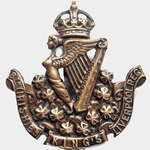Commemorated: | |||
| 1. Grave: | Tyne Cot Cemetery | VI. A. 5. | |
| 2. Book: | The (1921) Masonic Roll of Honour 1914-1918 | Pg.128 | |
| 3. Memorial: | The (1940) Scroll - WW1 Roll of Honour | 55B GQS | |
| 4. Memorial: | Liverpool Masonic Hall War Memorial | Col.2. Hope St. | |
Awards & Titles: | |||
Family :
Son of Henry and Fanny Leech, of 65, Parkfield Rd., Liverpool.Service Life:
Campaigns:
- The First World War 1914-1918, World-wide.
| Unit / Ship / Est.: 1/8 The King's (Liverpool Regiment) |
1/8th (Irish) Battalion August 1914 : in Shaw St, Liverpool. Part of Liverpool Brigade, West Lancashire Division. February 1915 : transferred to North Lancashire Brigade. 18 April 1915 : transferred with Brigade to Highland Division; brigade retitled as 3rd Highland Brigade. 3 May 1915 : landed at Boulogne. 12 May 1915 : new titles adopted: 154th Brigade, 51st (Highland) Division. 17 January 1916 : transferred to 165th Brigade, 55th (West Lancashire) Division. 31 January 1918 : transferred to 171st Brigade, 57th (2nd West Lancashire) Division |
| Action : The Battles of Ypres 1917 (Third Ypres, or Passchendaele) |
31 July - 10 November 1917. By the summer of 1917 the British Army was able for the first time to fight on its chosen ground on its terms. Having secured the southern ridges of Ypres at Messines in June, the main attack started on 31st July 1917 accompanied by what seemed like incessant heavy rain, which coupled with the artillery barrages conspired to turn much of the battlefield into a bog. Initial failure prompted changes in the high command and a strategy evolved to take the ring of ridges running across the Ypres salient in a series of 'bite and hold' operations, finally culminating in the capture of the most easterly ridge on which sat the infamous village of Passchendaele. The Official History carries the footnote ?The clerk power to investigate the exact losses was not available? but estimates of British casualties range from the official figure of 244,000 to almost 400,000. Within five months the Germans pushed the British back to the starting line, which was where they had been since May 1915.
Detail :
On the first-day of Third Ypres, in which 12 Allied divisions were engaged, it was intended that the Liverpool Irish would initially act as moppers-up, entrusted with the responsibility of neutralising opposition on the front of the 2/5th Lancashire Fusiliers, before partial dispersal to other battalions and employment as brigade support concentrated on a line between two positions known as Keir Farm and Schuler Farm, east of the village of St. Julien.[37] The two battalions formed the left of the 164th Brigade, which was to secure the 55th Division's third objective ? the Green Line (Gheluvelt-Langemarck Line) ? after the capture of the Blue and Black lines by the 165th and 166th. Losses were sustained early in the advance from the battalion's trenches and steadily increased once beyond the Black Line.[38] Various concrete emplacements and fortified positions littered the battleground, representing a constant threat with the heavy fire they directed at the brigade. Some were seized by the moppers up, at one stage the 8th's D Company took upwards to 150 prisoners.[38] By 12:30pm, part of the Liverpool Irish had established itself on the Green Line to reinforce the severely depleted Lancashire Fusiliers in the proximity of Fokker Farm and Wurst Farm. The majority of the 1/8th concentrated near Schuler Farm. For almost two-hours, the newly-captured territory was subject to sustained bombardment by German artillery as a precursor to a concerted counter-attack against the Green Line, control of which was made more precarious by the exposure of the 164th's left flank. Unable to rectify the distance between it and the 118th Brigade, the contingent near Schuler Farm organised a fighting retreat with those who had withdrawn from the advanced positions back to the relative security of the Black Line. The remnants of the 1/8th, approximatey 163 in strength, were ordered to retire to their starting positions under the command of Captain Monks.[39] Among the dead was the battalion's field commander Major Harry Leech, who was killed along with six officers and 27 other ranks; 200 had been wounded and 88 were believed missing.[40]
Masonic :
| Type | Lodge Name and No. | Province/District : |
|---|---|---|
| Mother : | Temperance No. 2714 E.C. | West Lancashire |
| Joined : | St Michael's Temperance No. 3401 E.C. | West Lancashire |
Initiated | Passed | Raised |
10th September 1901 | 8th October 1901 | 12th November 1901 |
Three years of war service is recorded for Henry Leech. The contribution record shows this and that he was "Killed i/a date unknown." He was a founding member of St. Michael's Temperance Lodge No. 3401 at its consecration 9th September, 1909.
His mother lodge was Temperance Lodge No. 2714 where he was a member for 11 years, until his resignation on 17th September, 1912. He was a 26 year old "Corn Factor," resident at 8 Dingle Hill, Liverpool.
Source :
The project globally acknowledges the following as sources of information for research across the whole database:
- The Commonwealth War Graves Commission
- The (UK) National Archives
- Ancestry.co.uk - Genealogy, Family Trees & Family History online
- ugle.org.uk - The records of the United Grand Lodge of England including the Library and Museum of Freemasonry
Additional Source:
- Founder Researchers : Paul Masters & Mike McCarthy
- Researcher : Bruce Littley

